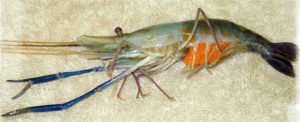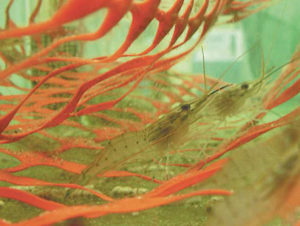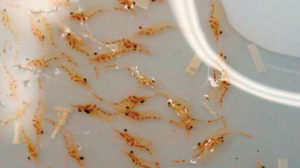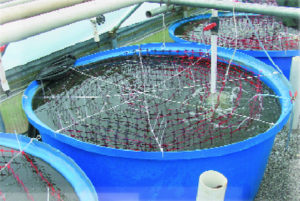Species differs from penaeid shrimp in multiple ways

The operation of a freshwater prawn hatchery in temperate climates presents a variety of challenges not found in the traditional greenwater or flow-through systems used in many parts of the world.
Most freshwater prawn hatcheries in temperate climates are located far inland. The 12-ppt brackish water needed for their larval culture is normally produced using commercial sea salt mixtures, which can account for a significant percentage of the budgets at hatcheries. With the high cost of U.S. $30 to $45 per 1,000 liters to produce artificial brackish water, most temperate hatcheries use zero water exchange in closed, recirculating, clearwater systems. Continuous water circulation through biological and/or mechanical filters is needed to remove solid and nitrogenous wastes.
Success is principally dependent on proper hatchery design and the management skills of operators. In these systems, it is necessary to provide everything the animals need in terms of lighting, nutrition, oxygen, temperature control and waste removal. In addition, alarm and emergency backup systems for electricity, particularly for aeration, are needed to prevent catastrophic loss.
Broodstock collection and maintenance
Broodstock are selected from ponds during the fall pond harvest, stocked in holding tanks at a 3:7 ratio of males to females, and maintained over the winter in indoor recirculating systems kept at 26 degrees-C. Artificial substrate is provided in the tanks at 1 square meter substrate per 10 broodstock. A 38,000-liter tank with artificial substrate can support approximately 45 kg of broodstock animals.
From September to December, broodstock can be fed a 32 percent-protein maintenance diet at approximately 1.0 percent body weight per day. One month prior to the start of hatching, broodstock are fed a high-quality, high-protein diet such as a penaeid shrimp diet at 1.5 to 2.0 percent body weight per day. This brood diet should also contain relatively high levels of highly unsaturated fatty acids, which can be top-dressed. In addition, chopped fish, squid, and beef liver can be fed as a supplemental diet.
Hatchery cycle

Around mid-February, broodstock are collected from holding tanks to initiate the hatchery cycle. Only ripe females with brown to grey-colored eggs are removed from the fresh water and acclimated over several hours to 12-ppt brackish water. The females are placed in individual, perforated containers and positioned in 500-l hatch tanks.
Eggs are allowed to hatch for two days, then females are sorted. Those whose eggs have hatched are returned to the broodstock tank, while those still carrying eggs are placed in another hatch tank. After two days of hatching, larval densities in the hatch tanks are 200 to 300 larvae per liter. The larvae remain in the hatch tank for seven to 10 days, where they are fed artemia twice a day based on a feed chart developed by Mississippi State University.
Larvae are then transferred to larger 3,000- to 4,500-liter larval tanks, with the larval density reduced to 40-100 animals per liter. Unlike adult prawns, which are benthic bottom dwellers, prawn larvae are pelagic animals suspended in the water column. In the larger tanks, they receive live artemia and a supplemental egg custard diet comprised of eggs, fish, vitamins, minerals, cod liver oil and binder. After approximately 30 days, most larvae pass through 11 larval stages of metamorphosis and transform into postlarvae (PL).
Postlarvae resemble miniature adults that no longer live suspended in the water column, but become benthic and more omnivorous. When approximately 95 percent of the larvae have metamorphosed to PL, the whole group is slowly acclimated to freshwater and moved to 3,800- to 38,000-liter nursery tanks.
Nursery stage

The nursery stage is an intermediate stage between the hatchery and grow-out ponds. PL are nursed indoors in insulated buildings or greenhouses for 45 to 60 days. Tank temperatures are maintained at 26 to 30 degrees-C for the duration of the nursery phase.
PL are stocked at a rate of 200 to 400 animals per square meter of added substrate. Substrates are constructed of 1-cm mesh bird netting supported by PVC frames. The PL are fed a commercial shrimp diet in a No. 1 or 2 crumble size.
Pond stocking
In temperate regions, production ponds are stocked in late May or early June with “60-day nursed juveniles” of 0.3 to 0.5 grams average weight. The larger juveniles are more resistant to predation, cannibalism and fluctuating environmental conditions in grow-out ponds than younger PL.
Also, in temperate regions the grow-out season is relatively short at 110 to 130 days. To attain a higher percentage of marketable animals, it is advantageous to stock the larger animals.

Prior to stocking in grow-out ponds, juveniles must be acclimated to the temperature and pH conditions of the ponds. Estimates of the number of juveniles stocked are based on counting and weighing several samples, and bulk weighing for pond allocation.
Comparison to penaeid shrimp production
Macrobrachium hatchery production is quite different from penaeid shrimp hatchery production. Macrobrachium females carry their fertilized eggs on their abdomens until they hatch, while penaeid shrimp randomly scatter their fertilized eggs. Penaeid larvae typically become PL 9-11 days after hatching, as opposed to 25 to 30 days with macrobrachium. Many hatcheries in tropical locations stock penaeid PL directly into grow-out ponds or at 8-18 days past their PL stages. Because of the limited growing season in temperate regions, Macrobrachium PL are nursed for 45 to 60 days.

The longer larval cycle of Macrobrachium larvae results in the feeding of more artemia and supplemental diet, and the need to maintain larval tanks longer. Both result in higher production costs and risks than penaeid culture. Unlike intensive penaeid hatchery production, there is no need for the production of microalgae in Macrobrachium hatchery facilities.
Maintenance of broodstock during cold winter months can also represent significant expense and risk. And there is no proven commercial larval diet for Macrobrachium, so hatcheries must manufacture their own supplemental diets, a labor-intensive and costly practice.
(Editor’s Note: This article was originally published in the August 2004 print edition of the Global Aquaculture Advocate.)
Now that you've finished reading the article ...
… we hope you’ll consider supporting our mission to document the evolution of the global aquaculture industry and share our vast network of contributors’ expansive knowledge every week.
By becoming a Global Seafood Alliance member, you’re ensuring that all of the pre-competitive work we do through member benefits, resources and events can continue. Individual membership costs just $50 a year. GSA individual and corporate members receive complimentary access to a series of GOAL virtual events beginning in April. Join now.
Not a GSA member? Join us.
Authors
-
David Yasharian
Aquaculture Research Center
Kentucky State University
103 Athletic Drive
Frankfort, Kentucky 40601 USA[117,100,101,46,117,115,121,107,46,108,105,97,109,119,103,64,110,97,105,114,97,104,115,97,121,100]
-
Shawn Coyle
Aquaculture Research Center
Kentucky State University
103 Athletic Drive
Frankfort, Kentucky 40601 USA -
James Tidwell, Ph.D.
Aquaculture Research Center
Kentucky State University
103 Athletic Drive
Frankfort, Kentucky 40601 USA
Tagged With
Related Posts

Responsibility
Freshwater prawn farming in Thailand
While the industry faces issues, freshwater prawn farming in Thailand offers a lucrative alternative to other forms of farming on small farms.

Innovation & Investment
Monosex culture of prawns through temporal androgenic gene silencing
A newly developed technology for producing all-male populations of freshwater prawns by temporal silencing of the androgenic gland insulin-like gene marks the first RNA interference-based biotechnology to be commercialized in the field of aquaculture.

Health & Welfare
The history and future of the Aquaculture Pathology Laboratory
The University of Arizona’s Aquaculture Pathology Laboratory has significantly contributed to the expansion of the shrimp farming for three decades.

Intelligence
Freshwater prawn seed production, culture expand in Vietnam
Hatchery development for freshwater prawns, based on the modified greenwater system, is making expansion of aquaculture in Vietnam’s Mekong Delta possible.


